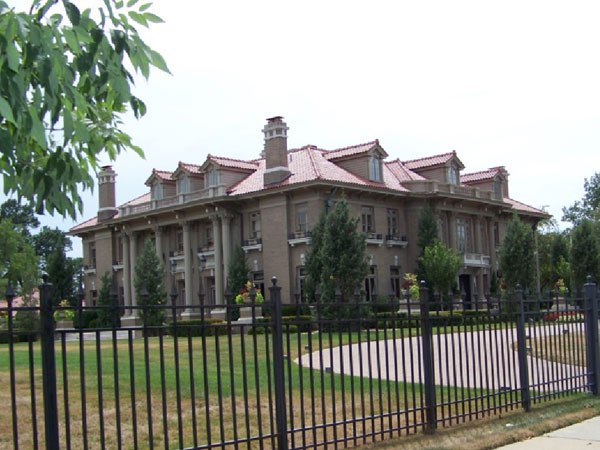Ward Parkway: Kansas City, Missouri

Summary
Ward Parkway is Kansas City's eminent thoroughfare, a right-of-way that begins at Country Club Plaza and transitions to a grand boulevard with manicured lawns and gardens as it follows sweeping curves southward. A commitment by both citizens and city government to maintain the parkway has allowed it to remain one of the area's most coveted addresses with historic homes, neighborhood parks, picturesque fountains, ornamental monuments, and rolling landscapes.
Designated Area
Twelve miles of the parkway between Brookside Boulevard and Wornall Road.

The Seahorse Fountain, located at Ward Parkway and Meyer Boulevard. The latter right-of-way was named after Kansas City's park and boulevard system pioneer August Meyer. Photo courtesy Kansas City, Missouri, Parks & Recreation Department.
Planning Excellence
Young land developers Hugh Ward and J.C. Nichols envisioned a majestic boulevard in 1907 that would surpass all others in Kansas City and enhance the value of their neighboring land. To guarantee their goal, they employed George Kessler, a landscape architect and Kansas City, Missouri's parks and boulevard designer, to create a "great parade of America." The first homes built on the parkway are across from each other at 1200 W. 55th St. and 5500 Ward Parkway, the latter the 30,000-square-foot mansion of early 20th century lumber tycoon Mack Nelson.
As Ward Parkway continues south following the natural terrain, visitors encounter the parks, fountains, and historic homes that make the parkway unique. A 90-foot-wide median allows pedestrians to meander from one amenity to the next, including the two creeks that occupy the center for a short distance.
Near the southern end of the parkway is a business area anchored by international engineering firm Burns & McDonnell, employer of thousands of area residents. The Ward Parkway Center, built in 1959 and extending from West 85th Street to West 89th Street, contains the country's first multiscreen theater located inside of a shopping center. The city's five-year capital improvements plan for 2012-2013 includes several maintenance and enhancement projects for Ward as well as the city's other parkways.

The Mack B. Nelson mansion is one of the earliest examples of opulence built along Ward Parkway. Nelson, a lumber magnate who moved to Kansas City in 1894, built the house in 1914. Photo courtesy Kansas City, Missouri, Parks & Recreation Department.
Defining Characteristics, Features
Parks, Monuments, Fountains
- Plaza Tennis Courts, Broadside Boulevard and Ward Parkway; 14 courts along Brush Creek
- Arno Park, Arno Road and Ward; favorite of residents with playground, basketball court, fields
- Russell Majors Waddell Park at W 84th Street and Ward Parkway
- Sea Horse Fountain at Meyer Circle; August Meyer developed city's park and boulevard system
- Mirror Pool, West 61st Terrace and Ward Parkway, built 1924 and refurbished 1965
- Romany Fountain, Romany Drive and Ward Parkway, has pedestal fountain and sunken garden
- Monuments: Chinese Warriors, Meyer Circle Gateway, the Eagle, the Wagon Master, Sister Cities International Bridge, United Daughters of the Confederacy Memorial, Venetian Relief
Parkway Funding, Improvements
- Ward Parkway Center Community Improvement District, West 85th Terrace, Ward Parkway, West 89th Street and State Line Road; one percent sales tax for Ward Parkway Center redevelopment
- One cent capital improvement sales tax, renewed until 2017, helps fund parkway projects
- Arterial impact fee assessed on new development on Ward Parkway to fund road work
- City allocates more than $9 million for park maintenance annually including $4 million for park grounds, trees, and facilities maintenance along parkways; $350,000 for parkway fountains and monuments; $250,000 for tennis courts
- Brush Creek Basin Feasibility Study resulted in a watershed plan and commitment to $31 million towards upkeep, new amenities by 2016; creek adjacent to northern segment of parkway
- Private donations provide partial funding for tree replacement and mowing along Ward Parkway
Historic Architecture
- Construction on parkway requires Historic Preservation Commission certificate; urban design guidelines for buildings along parkway adopted 1996
- Park Manor Historic District, 910-920 Ward Parkway; national historic site designated 2006. Three apartment buildings designed by Elmer Boillot and Jesse Lauck; three- and four-story Spanish Colonial buildings feature buff brick veneer accented with cast stone
- Serena Apartment Hotel, a nine-story Italian Renaissance Revival Villa, 325 Ward Parkway ; added to National Register of Historic Places 2009
- Several parkway residences added to National Register of Historic Places, including Alexander Majors Antebellum house at West 83rd (1970); Prairie-style Bernard Corrigan home, designed by Louis Curtiss, at West 55th (1978); two-story Neo-Classical Revival George Nicholson home at West 58th (2005)

Ward Parkway begins at The Country Club Plaza, a feature that has made it one of the most desirable addresses in the area. A median allows pedestrians to reach other amenities while enjoying a peaceful stroll over the creeks that divide the parkway. Flickr photo by ChrisM70 (CC BY-NC-ND 2.0).


